
Including one of the lightest waterproof jackets on the market, a budget-friendly alternative that's still light enough for most users, and overtrousers that pack away so small they're barely there, Rab's latest minimalist shells are equally ideal for summer running and weight-conscious backpacking, say Dan Bailey and Sarah Douglas.
When it comes to waterproofs for running - or, for that matter, minimalist backpacking - it's tempting to assume that less is necessarily more. Of course saving weight on your shell will be welcome when it's stuffed in a pack or vest; but what about when it's time to put it on? In rain and wind up a hill, far from shelter, most of us would probably agree that lightness alone isn't enough; function matters too. Rab's lighter shells, the Downpour Trail Light and Phantom, both strike a sensible balance in this regard, cutting down on grams without too much sacrifice in features, protection and performance. But as with all such shells, they do have their limits.

Phantom Waterproof Jacket - £175
The Phantom Jacket is billed as one of the lightest waterproof shells available. It's certainly among the lightest we've ever used - though it's worth noting that we were reviewing c.100g shells 10 years ago, so it's not unique. Neither is this the first iteration of the Phantom that we've reviewed; however the new version does feature a couple of upgrades.
In use: what's it good for - and what not?
Its primary role is as a superlight shell when running, with obvious crossover into other weight-saving niches such as backpacking or fast-and-light summer hillwalking days. Its phenomenal packability makes this a fantastic just-in-case layer. As is usually the way with something this specialised, you're paying more compared to something a little more generalist like the Downpour Trail Light. However if you're seriously into hill running, competing in an ultra, or especially keen to limit your load when backpacking, then this may well be a worthy investment.
At 133g men's size L (104g women's size 10) the Phantom Jacket is about as light as you'd probably ever really need a shell to be. It feels nearly-not-there when worn, and barely perceptible when stuffed into a race vest or backpack. However that lightweight construction does come at the price of some durability compared to thicker, heavier jackets.
So thin it's practically see-through, the 7D 2.5-layer Pertex fabric really does feel weightless. While it's durable enough for the purpose, remember that this purpose is 'ultralight just in case layer' not 'regular waterproof workhorse'. As with the original version, you wouldn't want to take it scrambling too often, or tangle with undergrowth; this is one jacket we'll be saving for 'best', and we're far more likely to bring it on a trip when conditions are on-and-off rather than regularly wearing it for all day downpours.
However, having subjected it to plenty of weather, we can say with confidence that despite its thinness the fabric is totally waterproof (HH: 20,000), and it's light and breathable (MVTR: 20,000 g/m2/24hrs) enough that the Phantom can be worn comfortably on the go (within reason) and even to an extent in replacement for a windproof when it's not actually raining.
What's changed?
The previous version of the Phantom jacket featured only a half zip, whereas the new model has moved to full zip, an improvement for most users that makes it easier to get on/off and vent. Where previously it came with a separate stuff sack, the new version's is integrated. There's been a modest price increase too, as you'd expect given inflation.
Fit
Some running shells are notably short and tight, but the Phantom is sized to fit comfortably over a couple of inner layers, and has a hem length that sits well below waist level to offer decent body coverage, with a slightly dropped hem for more protection at the rear. Sleeve length is generous, with a differential cut at the cuff to better cover the backs of your hands. Arm movement is unrestricted, and though there's a lot of hem lift with raised arms it's worth remembering that you don't often wave your hands in the air when running.
Hood
The hood is as minimalist as the rest of the jacket, with a tiny bit of stiffening in the brim to help slightly manage wind-flapping, and a modicum (really only token) of adjustment at the rear. It can be rolled and fastened away when not needed.
One neat feature is the addition of tiny perforations at the back of the hood, which let some of the wind pass through from the front to reduce the billowing effect; these are covered by the flap that becomes the jacket's stuff sack, so do not let the rain in.
Features
With no pocket and no hem adjustment, this is a shell reduced to bare basics. In this minimalist niche the lack of pockets is no drawback since you'll likely be wearing it with a running vest or pack. We do miss the presence of tightening at the hem however, since the jacket is cut fairly loose around the waist and there's nothing to stop it catching the wind; perhaps this was a weight saving too far?
Phantom Waterproof Pants - £125
Matching with the jacket, the Phantom pants in the same super-thin fabric offer waterproof legwear at a wraith-like weight and packability. These are among the lightest waterproof trousers available, something we really appreciated during a late spring backpacking trip on the Cape Wrath Trail, where every gram mattered. For this they were paired not with the Phantom Jacket, but the Downpour Trail Light (see below), a combo that worked well.
In use
Weighing just 92g men's size L (84g women's size M), and squashing down very small into the pouch sewn in the waist band, these trousers are lighter than most running shorts. That's obviously amazing when it comes to carrying them in a vest, and also helps make them feel super-airy when worn. There is a clear disadvantage though: perhaps even more so in trousers than with a jacket, that thin fabric and minimalist construction suggest they wouldn't long survive prolonged rough use. Though we've yet to damage ours, it's fair to assume that rocks and heather will eventually take a toll.
Despite its nearly-not-there lightness, the fabric is reliably waterproof, and over several days of very rigorous weather on the Cape Wrath Trail we never once got wet legs. It's also more than adequately breathable, so when you're out in on-off showers you can comfortably keep wearing the overtrousers in all but hot sun, without drowning in sweat. They're great for running and hillwalking alike.
Fit
Roomy enough to allow full freedom to move, yet without feeling baggy or flappy, the active cut of the Phantom Pants is brilliant. For running, these are among the best-fitting overtrousers we've used.
Features
There's a wide-flared lower leg to make it easier to get the trousers on and off; this is reduced using a popper and velcro fastener to give you a neater ankle. The arrangement works fine, though feels less substantial than something like a drawcord would be. We have used this feature when caught in on-off downpours, as it's preferable to taking off your shoes every time the trousers need to be put donned or removed. However on larger shoes (Dan's size 47 for instance) it is a very tight fit, and there's a limit to how often you want to be pulling this ultra-thin fabric over bulky or hard-edged footwear.
Downpour Trail Light Waterproof Jacket - £130
Compared with the Phantom, this jacket's longer and roomier cut, relatively thicker and more robust fabric, and more extensive feature set (beefier hood, hem adjustment, chest pocket) make it a better all-rounder, and the one you'd probably prefer for a long wet day in the hills. Because of this, and despite it being a bit heavier, this is the one we chose to carry on the Cape Wrath Trail, where multiple days of bad weather couldn't be ruled out.

In the event it was a trip of two very different halves. For the first week of hot and dry conditions the waterproofs did not make it out of our rucksacks, and when we thought about them at all it was in the context of how light and packable they were. Then things went downhill, with several days of strong gusty wind and sharp downpours. Here's where these thin jackets hit their limits, offering just-about-adequate protection, but failing to keep all the wind-blasted rain and hail fully at bay. For longer trips, or days of uncertain ferocity, any decision on which shell to carry is likely to be a compromise between weight and protection, so it's just worth noting that the Downpour Trail Light sits at the lighter-but-less-armour-like end of the scale.
In use: what's it good for - and what not?
The comparative heavyweight in this review, at 216g men's size L (172.5g women's size 10), the Downpour Trial Light may be less of a niche minimalist than the Phantom, but it'll be plenty light enough for many users. For summer hills or backpacking it's a real winner, giving you a fair bit of waterproof jacket for still a very reasonable weight. I'd have no problem taking it hill running too, particularly in colder or stormier weather when its thicker fabric and slightly beefed-up features would feel a bit more protective than the Phantom's. Overall this is a versatile shell, and its modest price tag would make it brilliant value for anyone looking to save a bit of weight without lightening their wallet too far.
The Downpour Trail Light's 2.5-layer Pertex Shield 2.5-layer fabric provides reassuring waterproof performance in full-on rain (HH: 20,000mm), and at 20D it's thicker, tougher and generally a bit more protective-feeling than the 7D fabric used on the Phantom, making this more of an all-season jacket. It's similarly breathable (MVTR: 20,000 g/m2/24hrs), and we've found it comfortably un-clammy when worn on the move. It's got some stretch too, which really helps with overall freedom of movement. One slight downside is that the fabric does soon wet out slightly in heavy weather; it's worth noting that this is a fact of life with all modern fluorocarbon-free DWR treatments, your recourse being more frequent washing and reproofing.
Though we like our two-tone jackets, our only gripe is the rather dull colour selection overall: brighter colours would be better for photography, and from a hill safety point of view.
Fit
Cut a similar length to the Phantom, the Downpour Trail Light Jacket offers decent below-waist coverage to keep as much weather out as possible. It feels slightly roomier in the body, easily accommodating a couple of inner layers without being too baggy or billowy. Sleeve length is generous, with a longer cut over the back of the hand for more protection, and overall freedom of movement feels good - helped by the stretch fabric. To cool down on the go, you can push the sleeves up over your forearms.

Hood
With a high collar, the Downpour Trail Light Jacket keeps the neck and chin well covered. The stretch-bound hood offers a decent level of coverage too, and a modicum of adjustment at the rear (though really not much). There's a small slightly stiffened brim to help give a bit of structure, but as you'd expect in such a lightweight shell the hood can only do so much in stormy conditions, and does tend to catch and flap in the wind. At times we've noticed the wired peak digging a little into the forehead, something that seems to happen when the hood is being pulled down onto your head by your rucksack straps. As with the Phantom, the hood can be rolled away when not needed.
Features
This is a stripped-back jacket, but not an ultra-minimalist one.
You get a decent-sized chest pocket for a hat, snacks or a phone. For ease of packing the jacket stuffs into this, but annoyingly there's no loop to hang it off your bag or harness. A hem drawcord helps give you a close fit to keep the weather out, but only around the rear and not at the front, an arrangement that is adequate unless things are particularly stormy. The cuffs have no adjustment or fastening, but do sit low to help cover the back of your hand.
The product info promises to keep you running through horizontal rain, but in the real world it is worth noting that - as with all such things - the lightweight 'water resistant' zip has its limits. In wind-blasted hail and downpours we've found that under-layers soon get soaked in front, as water is forced through the zip. The jacket fares much better in rain minus high wind. With such a lightweight shell there's almost inevitably going to be this sort of trade-off in terms of weather protection.
































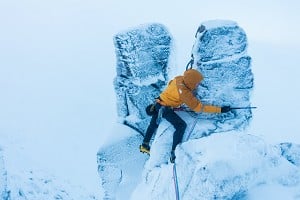





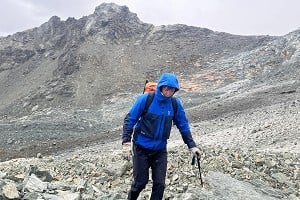





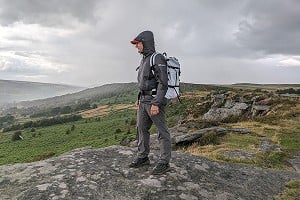
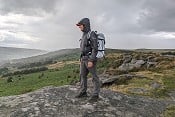




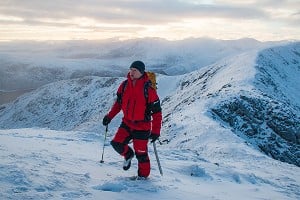

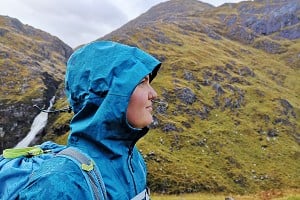
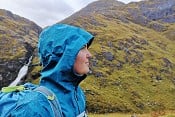


Comments